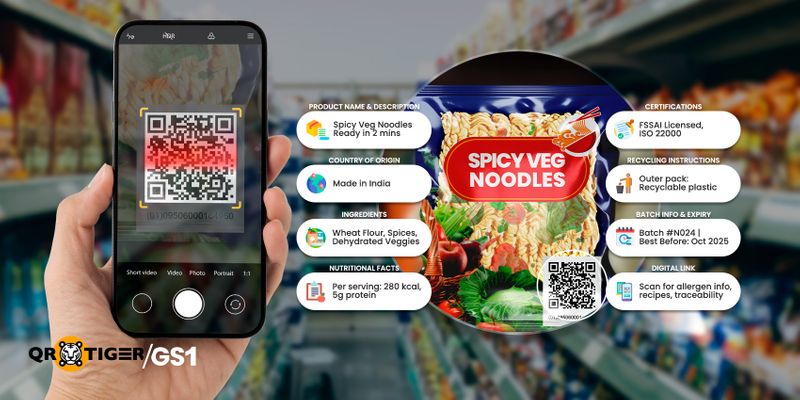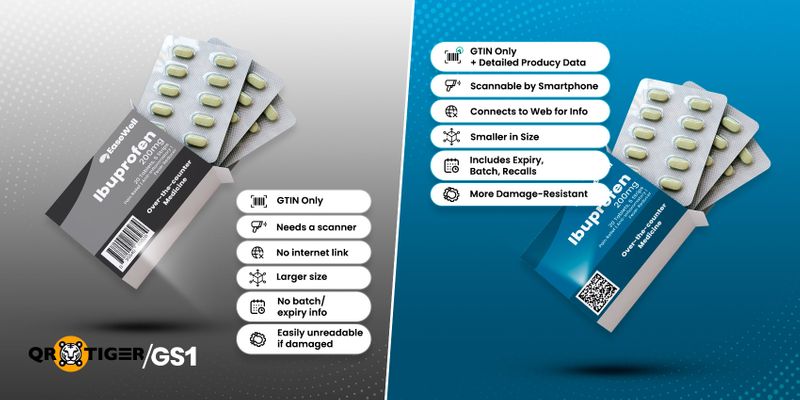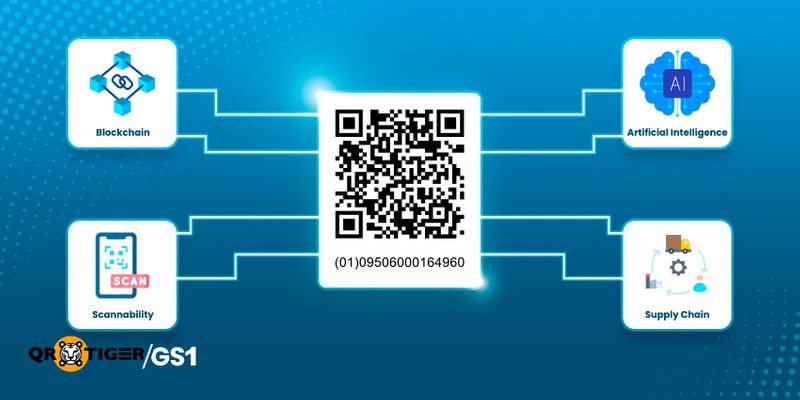What are Next Generation Barcodes, and What Makes Them Great

The global standards body GS1 plans to introduce next generation barcodes from 2027 to enhance the traceability of products, consumer trust, and supply chain efficiency. It is currently being tested in a few countries including Australia, Canada, etc.
GS1 aims for 2D (two-dimensional) barcodes to be scannable on POS by 2027 to enhance supply chain traceability, support recall tracking, and integrate with smart technologies.
People everywhere—shoppers, brands, stores, and regulators—want more details about products. Therefore, scanning a code on packaging is becoming a key approach to access information easily. Most barcodes today provide a very limited amount of information.
This article discusses how next-gen barcodes are transforming digital identification, why they are game-changers, and what’s new in barcode technology.
Table of Contents
- What is a barcode?
- What are next generation barcodes?
- Why shift to 2D barcodes?
- How do next-gen barcodes differ from the current barcodes?
- Technology for the modern barcode systems
- What updates are needed to shift to 2D barcodes
- Opportunities with modern barcode systems
- Success stories for future-ready barcodes
- Unlocking efficiency and transparency with next-gen barcodes
What is a barcode?
A barcode is a general term for a machine-readable representation of data. It includes various formats such as 1D barcodes—commonly seen as parallel black-and-white lines in retail settings and 2D barcodes like QR codes, which appear as pixelated squares capable of storing more complex data.
Barcodes are used to enter data into computer systems and are typically found on products for managing transactions and tracking inventory. An optical (laser) scanner, a part of a computer system reads the barcode information.
The major advantage of a barcode tracking system is that it allows users to process information instantly when the barcode is scanned, rather than storing information for later processing.
What are next generation barcodes?
Next generation barcodes leverage well-established technologies like QR codes and DataMatrix. While these formats have existed for decades, their application is new since they have never been used for POS (retail checkout) before.Enabled by GS1 standards, innovations such as Digital Link URI–powered QR codes and GS1 DataMatrix are set to enhance product traceability, supply chain efficiency, and consumer engagement.
During this period, a brand owner can add a next generation barcode alongside their linear barcode. The shift to next-gen barcodes is expected to transform commerce, making transactions more efficient, transparent, and consumer-friendly.
Sunrise 2027 is an international initiative that encourages retailers to integrate GS1 2D barcodes, such as Data Matrix and GS1 QR codes, into their point-of-sale systems by 2027. It is not a hard deadline but indicates the beginning of a unified industry-wide initiative to optimize systems.
Note that for the suppliers and manufacturers, the transition to the next-gen barcodes is not mandatory. The supplier can continue to use the linear barcode if desired.
The number of online shoppers worldwide is expected to grow by 4.92%, reaching 2.77 billion by 2025. As e-commerce expands, the demand for effective product authentication, real-time tracking, and enhanced digital engagement will drive the widespread adoption of next-gen barcodes, enabling businesses to deliver smarter, more connected consumer experiences.
QR codes
QR code scans reached 41.77 million globally in 2025, representing a 433% increase over the past four years. This indicates that QR codes are not widely used across industries.
A GS1 QR Code is a 2D barcode that stores data vertically and horizontally. It can encode more information than a traditional linear, like Universal Product Codes (UPCs), found on products that a cashier scans at checkout.
The QR code is designed to share comprehensive product information, such as batch number, additional product ID, weight, expiry date, dimensions, variant, and certification. They let consumers access linked web content by scanning the product QR Code on the packaging.
There is a push to use 2D barcodes because they store more data, improve traceability, and enhance consumer engagement. Unlike traditional 1D barcodes, they can encode batch numbers, expiration dates, and product details in a compact format, so they are promoted as replacing barcodes.
The built-in Reed-Solomon error correction on GS1 QR codes makes the essential supply chain data accessible even when the package is partially damaged. Error correction is one of the key advantages of 2D barcodes, and it is not available in 1D barcodes.
GS1 DataMatrix
GS1 DataMatrix is a matrix (2D or two-dimensional) barcode that may be printed as a rectangular or square symbol made up of individual dots or squares. It uses a data format, called GS1 element string syntax.
It has the same embed capabilities as a QR code, enabling businesses to include Global Trade Item Numbers (GTINs) plus additional product information such as best before date, lot /batch number, serial number, expiration date, and more in a compact format.
As of now, the Pharmacy and Healthcare industries have identified GS1 DataMatrix as the barcode to meet their business needs. This is due a more robust error correction feature, effectiveness in direct to part marking (DPM).
GS1 DataMatrix (Data Matrix ECC 200 standard) and QR codes both use Reed-Solomon error correction algorithms to enhance data reliability. However, their encoding strategies differ: DataMatrix uses ECC 200 encoding, whereas QR codes follow a format-dependent structure with varying error correction levels.
These mechanisms allow both symbologies to detect and correct data errors, supporting robust performance in various scanning environments.
Unlike traditional barcodes, it can store large amounts of data in a small space, making it ideal for medical devices, retail, and logistics.
Why shift to 2D barcodes?
Consumers demand more information about the products they’re purchasing (such as usage instructions, ingredients, certifications, recycling instructions, traceability, and more).
Regulators require the disclosure of more information and there’s an ongoing need to more effectively track and trace products through the supply chain. This is where next-gen barcodes help.
With the “one barcode fits all,” one barcode on the label addresses all use cases. As a result, the scanning process becomes clearer and more efficient for all stakeholders involved (retailers, consumers, trading partners, etc.). You can choose between the QR code with GS1 compliant Digital Link or the GS1 DataMatrix.
QR codes and DataMatrix barcodes are not new. They’ve existed for years, mainly used for simple data storage and quick access to information. What’s changing is how they’re being applied in industries like retail, logistics, and healthcare.
Throughout the transition phase, products will feature both traditional barcodes and next-gen QR codes, ensuring compatibility with existing systems.
Benefits of upgrading
Point-of-sale (POS) integration: POS systems now leverage GS1-enabled 2D barcodes like DataMatrix and QR codes for enhanced product identification and faster checkouts. Their built-in error correction and omnidirectional scanning improve speed and accuracy.
Beyond efficiency, POS setups can flag expired or recalled products in real time during scanning, helping prevent unsafe sales and simplifying recall processes. These features position 2D barcodes as powerful tools for smarter inventory management and consumer safety.
Supply chain optimization: By using next-gen barcodes, a company can track products in real time, improving inventory management, possibly reducing counterfeiting, and enhancing efficiency.
Regulatory compliance: Industries like pharmaceuticals and food now require barcodes to hold not just product numbers but also expiry dates, recall info, batch details, and authenticity checks.
How do next-gen barcodes differ from the current barcodes?

Data capacity: Traditional EAN/UPC barcodes can store only product identification numbers. However, next-gen barcodes can encode detailed product information, including expiry dates and batch numbers.
Smartphone compatibility: Unlike traditional barcodes that need dedicated scanners, next-gen barcodes can be scanned using smartphone cameras, increasing accessibility.
The table below justifies the difference:Current barcode | Next generation barcode |
Contains only GTIN | Contains GTIN and more data |
No link to the Internet | Can include links to more information |
Larger | Compact |
Unreadable if damaged or poorly printed | Resistant to damage or poor print quality |
Technology for the modern barcode systems

These barcodes are powered by advanced technologies that enhance traceability, security, and efficiency across industries. Here are some key innovations:
Digital Link by GS1: The technology uses the GS1 Digital Link QR code that serves both supply chain operations and consumer-facing applications, such as accessing product details, coupons, and safety recalls via scan from smartphones.
AI & Blockchain integration: Next-gen barcodes support secure data sharing with the integration of blockchain and AI technology. So, they are ideal for industries requiring multi-party verification, such as healthcare and pharmaceuticals.
What updates are needed to shift to 2D barcodes
System updates will vary based on what equipment is already in place and use cases to be enabled. Scanning 2D barcodes requires an image-based scanner, so those with older laser-based scanners will need hardware upgrades.
If image-based scanners are already installed, you will need to check with your solution providers to see if software updates can be done to scan the new barcodes and process the data encoded in them using Application Identifiers.
The systems that will store and use the data in the barcode may also need updating. For example, systems may need modifications to stop the sale of an expired product based on the date in the barcode or they may have to be modified to capture and use a batch/lot number to support recalls.
Opportunities with modern barcode systems
Brand owners: Next-gen barcodes unlock a unified strategy, allowing you to enhance consumer engagement, optimize supply chains, and more. They boost brand interaction with instant product details and promotions.
Supply chain optimization is achieved with improved tracking, recalls, and product authenticity. Also, the brand owners meet regulations by providing essential recycling and environmental info.
Retailers: Transform operations and deliver an effective shopping experience. Next-gen barcodes empower retailers to boost operational efficiency and improve recall management.
If you are a retailer and are confused about how to generate GS1 QR codes then you can use a reliable platform like QR Tiger QR code generator. It helps you create dynamic QR codes for your business growth.
Solution providers: By offering cutting-edge systems and tools, solution providers can facilitate the transition to the new era of cutting-edge barcode standards, positioning themselves at the forefront of industry evolution.
Success stories for future-ready barcodes
These success stories suggest how companies are leveraging innovative barcode solutions to optimize operations and drive industry transformation.
Sistr Coffee’s Smart Packaging Solution
Sistr Coffee, a premium coffee and tea brand, was aiming to share its story and product details with customers.
However, since packaging design was a key part of their brand identity, they had limited space for additional information. They needed a way to inform consumers without compromising their sleek and stylish packaging.
To solve this challenge, Sistr Coffee collaborated with GS1 partners at Buyerdock to integrate QR codes powered by GS1 Digital URI.
These QR codes were placed on the back of their packaging along with clear instructions encouraging consumers to scan them. This allowed customers to access rich product information and engage with the brand without cluttering the packaging.
By using these QR codes, Sistr Coffee unlocked new opportunities, including strengthening brand loyalty, ensuring global compliance, reducing packaging costs, and delivering product details in innovative ways.
These smart barcodes instantly connect consumers to real-time digital content, making information more accessible and interactive.
Citrus Fruit enhanced traceability
The citrus industry in Australia successfully implemented next-generation 2D barcodes to enhance traceability, benefiting both consumers and supply chain partners.
The project has also prepared the industry for future regulatory requirements, allowing quick responses to food safety concerns.
Mildura Fruit Company, supported by Citrus Australia and Agriculture Victoria, introduced barcodes with GS1-resolvable URLs to track citrus fruits from farm to market, ensuring supply chain transparency and efficiency.
This innovative approach has strengthened brand protection, improved consumer engagement, and optimized collaboration within the supply chain. By using GS1 standards, citrus growers can now provide real-time product authentication, origin details, and sustainability information, making Australian citrus more competitive in global markets.
Unlocking efficiency and transparency with next-gen barcodes
Next generation barcodes are transforming how we share and track product information. The shift from traditional 1D barcodes to advanced 2D versions brings enhanced traceability, security, and digital connections. With Sunrise 2027 pushing global adoption, businesses that upgrade their systems can stay ahead. Adopting these barcodes will improve efficiency, transparency, and the overall shopping experience.DISCLAIMER: We acknowledge that GS1, as well as the materials, proprietary items, and all related patents, copyright, trademark, and other intellectual property (collectively, “intellectual property”) relating to its use, are the property of GS1 Global, and that our use of the same shall be in accordance with the conditions provided by GS1 Global.




